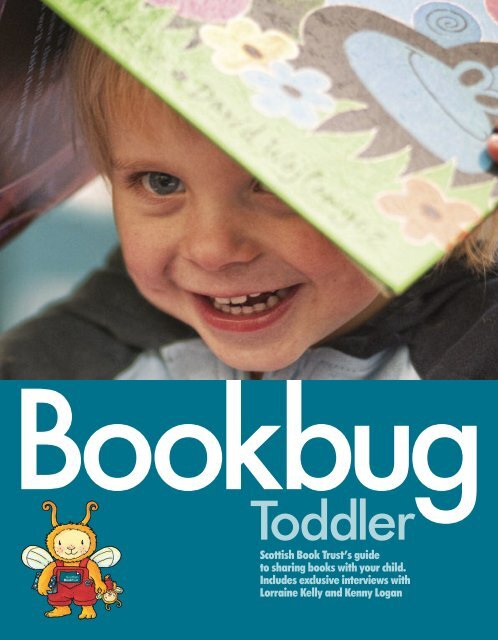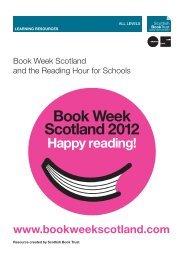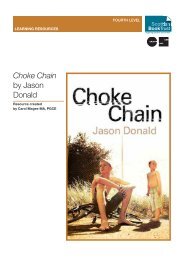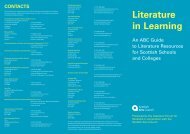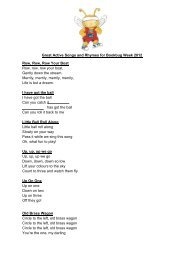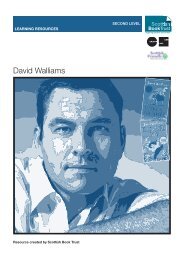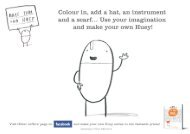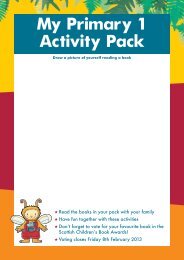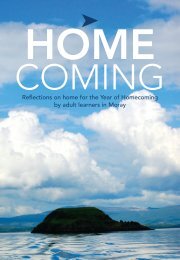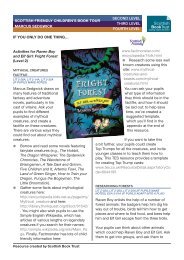Download PDF version - Scottish Book Trust
Download PDF version - Scottish Book Trust
Download PDF version - Scottish Book Trust
Create successful ePaper yourself
Turn your PDF publications into a flip-book with our unique Google optimized e-Paper software.
<strong>Scottish</strong> <strong>Book</strong> <strong>Trust</strong>’s guideto sharing books with your child.Includes exclusive interviews withLorraine Kelly and Kenny Logan
GETTING STARTEDand reread a lot of Tolstoy andTurgenev. I also like MarianKeyes and Maeve Binchy.HOW DO YOU RELAX? I do readbooks to relax but I also have toread for work. I’ve always got abook on the go. I like to go backto old favourites. My dad isreally interested in astronomy.It’s fascinating to look backat astronomy books that werewritten in the 1960s and see howthings have changed.WHAT INSPIRED YOU TO WRITEYOUR AUTOBIOGRAPHY,LORRAINE: BETWEEN YOU ANDME? A biography had come outand that was fine but it was a cutand-pastejob with lots ofmistakes in it. I thought it wouldbe good fun to write somethingmyself. I loved the process ofwriting – talking to my familyand finding out stories fromthem. But writing fiction is a realjob. If I did it, it would have to befor the right reasons – somethingI was devoted to and reallybelieved in.HAVE YOU EVER THOUGHT OFWRITING CHILDREN’S BOOKSYOURSELF? Children’s booksMy favourite places in ScotlandOrkney and BarraI am currently readingSouth by Ernest ShackletonI always wanted to grow up to beJo from Little WomenMy earliest memoryBeing outside our single end inthe Gorbals when I was abouttwo, bawling my head off becauseI had a scratchy woolly hat on!My daughter’s first word“Dada”, swiftly followed by “no”!are incredibly hard to write.It’s a very demanding audience!You have to have a talent forcreating an absorbing storythat’s completely engagingfor children. You need to bestarry-eyed!OUT OF ALL THE CELEBRITIESYOU’VE INTERVIEWED, WHOHAS BEEN YOUR FAVOURITE?ere are a few! GeorgeClooney and Will Smith arealways a joy to interviewbecause they treat the wholething as fun and make it soeasy for you. Paul O’Grady wasthe surprise host for my 50thbirthday show on GMTV andhe is a delight – funny andgenerous but with thatbrilliant waspish humour.And Peter Ustinov was lovely.He was a great communicatorLorraine'schildhoodexperiences ofbooks influencedhow she read toher daughterand an extremely well-read andabsolutely fascinating man.He could communicate withanyone without ever beingpatronising, which is a realtalent. He was a raconteur,writer and actor; he had sucha long and varied career.WHO IS YOUR FAVOURITECHARACTER, EITHER FROM ACHILDREN’S BOOK OR A BOOKFOR ADULTS? I loved Winnie thePooh. He was cheeky and a rebel– I really liked that. But myfavourite character of all timewould have to be Raskolnikovfrom Crime and Punishment.WHAT’S BEEN YOUR MOSTEMBARRASSING MOMENT ONGMTV? I was coming down thestairs on one of the shows and Ijust fell over! I have an earpieceso that the producers can tell methings while we’re on air and all Icould hear in my ear was themhowling with laughter! Whensomething like that happens youjust admit it and go with it. Istood up and I’d skinned myknees. I said, “Does anyone haveany ideas about how to helpsomeone who’s skinned theirknees?” And lots of people sentin suggestions.WHAT MADE YOU DECIDE TO STAYIN DUNDEE AND NOT MOVE TOLONDON? GMTV have allowedme to stay up here – they’ve beenfantastic. I do the Monday andTuesday shows live in Londonand then record two days. So I’monly away from home for twodays. It has meant that Rosiecould go to school in Scotland.I feel very lucky to be able to livehere. I love London but it’s greatto be able to live in Scotland andbe with my family – it’s thebest of both worlds. ●6<strong>Book</strong>bug
Sit back and relaxCuddling up together to read a story brings a surprising rangeof benefits for children and parents, as Suzanne Zeedyk explainsEmotionalbenefitsEffects on yourchild's brainand bodyEvery time your child enjoys timereading with you, importantneural pathways in their brainare being strengthened.If story time is part of a predictableevening routine, this will be goodfor the development ofthe'amygdala, which is a part ofthe brain that processes emotions.When your child cuddles up toyou, their body produces ahormone called oxytocin(sometimes called the ‘cuddlechemical’). This brings a feelingof contentment and security, areduction in the heart rate and asense of calmness and relaxation.This is an opportunity to shareexperiences and have fun together.You can link events in the story withyour child’s feelings, and explorenew emotions by talking about theexperiences of the characters.Your child will be anticipating yourattention. If they point to a picture ofa dog in a story, and say “Dog!”,they may turn to look at you andexpect a positive response. If you say“Well done!” or “Yes, that’s a dog,”you help reinforce their confidence,and emphasise a sharedunderstanding between you.If you aren’t a very confident readeryourself, don’t worry. Make up somestories about the pictures. The mostimportant thing for children is thatthey are having an enjoyable timewith you.Dr Suzanne Zeedykis senior lecturer indevelopmentalpsychology at theUniversity of DundeeLearning anddevelopmentYou and your child are giving jointattention to the story in bothpictures and ideas. This is an idealsetting for learning new wordsand concepts. You can also relatewhat you read to things your childhas recently experienced.Bedtime stories help to establish anunderstanding of boundaries. Youcan do this by telling your child howmany stories you’re going to readand then saying before the last one,“Okay, we will read one more storyand then we’ll say goodnight.”<strong>Book</strong>bug 7
GETTING STARTEDPracticaltips forparentsFollow our advice and helpgive your toddler a love ofreading for life1IT DOESN’T HAVE TO TAKE LONG! You justneed a few minutes every day to readtogether. Sit your child on your knee oranywhere close to you, and simply turn the pagesof a book, chatting about the pictures.2IT’S FUN Reading to your child helps youboth enjoy special quiet moments togetherevery day – and it’s the perfect time to havea cuddle!3READ ANYTHING Choose something thatyou like to read. It doesn’t matter whatyou pick – it could be stories, poems,comics or rhymes. If you enjoy reading, yourchild will notice.4READ TO YOUR CHILD AT BEDTIME It’s a greatway to end the day on a calm, positive notefor both of you. Your childwill sleep better if they feelrelaxed – and so will you!5BOOKS MAKE GREATPRESENTS Suggestto friends andrelatives that they buy yourchild a book as a gi for aspecial occasion. And if you go toa birthday party, buy a book – it’s cheap and it’ssure to go down well.6EVERYONE CAN HELP Encourage everyoneto share books with your child –grandparents, carers, older brothers andsisters, and friends. ey could also recommendfavourite stories, authors or places to get books.8<strong>Book</strong>bug7TAKE A BOOK WITH YOU WHEREVER YOUGO You can look at it with your child whenyou’re waiting for the bus, visiting thedoctor or sitting on a train. Children are betterbehaved when they have something to focus on,and reading a storybook is ideal.
ensuring that booksbecome a central part oftheir life.9JOIN YOURLOCAL LIBRARYChildren arenever too young to join.It’s free and you can borrowa great selection of books. Let yourchild pick books they like – and choose a few you’dlike to read too!10BOOKSENCOURAGE WRITING Sharingbooks together will inspire your childto begin drawing, writing and comingup with their own stories.8BOOKS DON’T HAVETO STAY ON THEBOOKSHELF! Make surebooks are easy for your child tofind and pick up around thehouse. Why not put a few insideyour child’s toy box too? Orunder their pillow, or in thebathroom? It’s a simple way ofMy experience…Alison (28), mum to Gemma (four),and Rory (18 months)“My kids both like books with texturesto touch or little doors to open. They likebooks with strong rhythms and brightlycoloured pictures. I found it hard atfirst when the older one wanted thesame books again and again but Irealised that this really helped herunderstand the stories. Now she hasYOUR CHILD BECOME A BOOKLOVER It won’t be long before your child11WATCHbrings their favourite books to you,asking you to read with them. Children lovereading the same book again and again andknowing what happens next – so enjoy it withthem! Follow their lead and look forinteresting new details on the page.12AND DON’T FORGET –READING TO CHILDREN GIVESTHEM A HEAD START IN LIFESharing books with your child will helpdevelop their listening and language skills.ey will also find learning to read mucheasier when they start school. ●started wanting to make her own little‘books’ by sticking her drawingstogether. When I was heavilypregnant with my second child, bookswere a lifesaver. When I got exhausted inthe afternoons I would snuggle up withmy daughter and read whilegetting a lie-down!”<strong>Book</strong>bug 9
GETTING STARTEDMeaningfulmarksYour child’s early attempts atwriting can be fascinating andfun. Moira Leslie explains whatyou can do to encourage themSHARInG storybooks andrhymes with children fromday one is great fun. It isalso likely to have apositive impact on their earlyliteracy development.Talking, reading and writingare all connected, so as well asfrequent book-reading, yourchild will benefit from lots ofopportunities to explore and playwith different writing materials.Try to involve your child asoen as possible in activitiessuch as writing shopping lists,birthday cards and notes. Asyour child sees you writing,reading back what youhave written and talkingabout why you arewriting, they willprobably want tohave a go atwriting too.Praise andencourage yourchild wheneverMaya, 22 months,drawing a playpark (below),and an envelopeon which shehas written hername (above).Note the ‘m’you see him or herexperimenting with writingwhile playing.Talking with young childrenabout their mark-making andearly attempts at writing is animportant first step in helpingthem understand theconnections between readingand writing.You are unlikely to be able to‘read’ any of your child’s earlypieces of writing! Very earlyattempts will take many forms –they might look like randommarks or scribbles on the page.Later, you might be able to pickout shapes that look likeinvented or recognisableletters, perhaps fromyour child’s name.Whatever yourchild produces,show that you areinterested in it andthat you feel it isimportant. Youcan do this by having aconversation about what theywere thinking when they did thewriting, and by asking them toread it aloud to you. By joiningin this enjoyable writing playwith your child and talkingtogether, you will begin to findout what he or she understandsabout writing. is will give youideas about how to support anddevelop this interest.Young children’s mark-makingand early attempts at writing arefascinating. Collect examples asyour child is growing up and youwill have a precious keepsakefrom these important first yearsof development. ●Dr Moira Leslie is a lecturer atMoray House School of Education,University of EdinburghTop tipsAlways have lots of drawing andwriting materials at hand so thatyour child can choose to draw,write and make marks duringtheir play.Make a book of your child’sfavourite rhymes. As you both saythe rhymes together, write thewords on the page to begin toshow the link between the wordsyou say and print on the page.10<strong>Book</strong>bug
Count me inEverydayactivitiescan helpyoungchildrengrasp thebasics ofmaths,explainsProfessorAline-WendyDunlopProfessor Aline-Wendy Dunlopis chair ofchildhood andprimary studiesin the Faculty ofEducation,University ofStrathclydeWHEn MY first grandchild was threeweeks old, my younger daughter andI were visiting just before bath time.Calum was lying kicking on his bathtowel. His admiring audience sat close in, faceswithin his view. He looked from one adult face toanother in turn. en his mum went to fill hisbaby bath. Calum again looked round the faces– one, two, three – where was his mum? One,two, three, and he cried.As a fond granny with a passionfor child development, I declared,“Calum’s going to be great at maths –he’s counting already!”How can we ensure that children growup with a useful grasp of mathematicsand numbers? Opportunities to developbasic numeracy surround us in oureveryday lives. Parents and carerstypically chat to even very youngchildren about the mathematical tasksthey themselves undertake.Almost every activity during theday provides opportunities to talkabout numbers with little ones. esecan include:• Writing a shopping list with ‘how many’ of eachitem is needed• Pressing the button for the right floor in the li• Spotting the bus number at the bus stop• Buying enough sausages for tea• Making sure there is a cup or piece of toast orapple for everyone• Looking at books such as e Very HungryCaterpillar which make numbers, counting andsequencing part of the story• naming and counting everyone in a family photo• Singing songs such as ‘One, two, three, four, five,once I caught a fish alive’• Playing with fingers and toes• Pouring water in and out of containers in the bath• Stacking beakers by size• Counting candles on birthday cakes• Sorting the washing into piles• Picking up shells, leaves, sticks, clothes pegsand toys• Counting the steps upstairs to bed.ese everyday activities indirectly and quitenaturally help little children to enjoy ‘the languageof maths’ from an early age.Most children will soon notice if there is abanana short at teatime, if there aren’t enoughsweeties to go round or if one foot has lost its sock.With the help of their parents, children willnaturally develop a playful understanding ofnumber, colour, shapes, groups, one-to-onematching, counting, classifying and sequencing.A child who uses number concepts in thesepractical ways is already a mathematician!A strict or formal approach to numeracy is notneeded with the youngest children. But an adultwho notices maths and numbers in everydaythings can help children to be observant too,to count, to use number names and to have funin a practical way. ●<strong>Book</strong>bug 11
SUPPORTING YOUR CHILDBreakingdownbarriersRugby player Kenny Logan talksabout fatherhood, his first book –and why being dyslexic doesn’thave to hold you backHOW OLD WERE YOU WHEN YOUFOUND OUT THAT YOU WEREDYSLEXIC? I was 16 or 17. I livedthrough my childhood thinkingI was thick. It wasn’t until ateacher helped me aer schoolthat I understood. e onlything I was told was that it wasn’tabout being stupid. My teacherstarted telling me about peoplewho were dyslexic who had beenvery successful, like WinstonChurchill and Jackie Stewart,and that made me feel better.e first book I read was Lassie,which is probably aimed at anine or ten-year-old child. attook a year to read. I was so tiredby trying to read it – I couldn’ttake it in.WHAT WAS IT LIKE WRITINGYOUR AUTOBIOGRAPHY, JUSTFOR KICKS? e best thing aboutthe book was actually doing it –I wrote about and talked aboutthings I’d never opened upabout before. It was a journey.When I got to the part aboutschool I didn’t want to continuewith it because it was such a sadpart of my life. But then I gotinto it again. Talking aboutdyslexia and seeing how otheryoung children cope with it hasThe onlything I wastold was thatit wasn’tabout beingstupidmade me understand it betterand feel good about it.WHAT KIND OF SUPPORT DOYOU THINK DYSLEXIC CHILDRENNEED TO BE GIVEN BY THEIRFAMILIES? It’s really importantto recognise that every childis different. My wife Gabby andI have twins, a girl and a boy.My daughter, aged four, takeseverything in like a sponge, butwith my son you have to sit downand really talk to him. e mostimportant thing is praise – talk tothem, help them understand,spend time with them, and bepositive. I don’t shout at them, Ispeak to them. I try to treat themas if we’re players in a rugby team– you go and help them!Communicating with your kidsis essential. I don’t think I couldhave told my mum or dad that Icouldn’t read; I was so frustratedas a kid and it hindered me.Children need to be able to speakand be heard by their mums anddads and teachers.HAVE YOU ENCOUNTEREDPREJUDICE ABOUT BEINGDYSLEXIC AS AN ADULT? In thepast the hardest thing for mewas telling people. But now if Ican’t spell someone’s name I justask them, even if I have to askthem three times – by the thirdtime I’ll definitely be able towrite it down. I’m lucky – if I say12 <strong>Book</strong>bug
I’m dyslexic people areinterested because I’m in themedia. I le school withouta qualification and I didn’t goto university, but I’ve done okayas a rugby player and then inbusiness. In the business worldthere are many people who aredyslexic or who can’t read butthey’re hugely successful andhappy in their careers. It doesn’thave to hold you back.WHAT WAS THE NICEST THINGTHE RUGBY COMMENTATOR BILLMcLAREN EVER SAID ABOUTYOU? He used to call me “a sonof the soil, a little farmer boyfrom Stirling”! I had a lot ofrespect for him; I grew uplistening to him, and he was oneof the biggest influences on myrugby career. He was the nicestman, and such a big figure inScotland – he was loved. Whenyou travelled around the world,the first question from otherrugby players would always be,“Have you met Bill McLaren?”His commentary was so honest;he made you feel like you werepart of the game.WHAT HAVE BEEN THEHIGHLIGHTS OF YOUR RUGBYCAREER? Four things stand out.Winning the league for StirlingCounty in 1994/95. Winning theFive nations in 1999 playing forScotland – not many people getthe opportunity to play for theircountry and win for yourcountry. Moving to [Englishprofessional rugby union team]London Wasps – going to a bigclub and having such an impact.And the amount of good peopleI’ve met through my rugbycareer has been very special.I look back at rugby and enjoyand appreciate everything that ithas given me. ●Exposure to books is essentialwhen learning to read – andparticularly helpful for childrenwho may be dyslexic, writesKathleen ClarkKathleen Clarkrecently retiredas a seniorlecturer at theUniversity ofStrathclydewhere she wascourse directorof the Mastersprogramme ineducationalsupport. Herspecialist areais dyslexiaDYSLExIA,as literallytranslated,means adifficulty withwords. It canresult in childrenstruggling to learnto read and write.Dyslexia has othercharacteristics inaddition to poorliteracy development.It tends to run in familiesand can affect spokenlanguage development, coordination,memory skills,organisational skills, andthe processing of informationreceived via the ears and/orthe eyes.Unfortunately it is morecommon to hear about thenegative aspects of beingdyslexic rather than thesuccess achieved by manywho are affected by it. It is asubject that can cause muchanxiety for parents.EXCEPTIONAL CREATIVITYRecent research refers todyslexia as a ‘difference’in the way the brain deals withlearning, rather than somethingwrong with brain function. Manypeople who are dyslexic haveexceptional talents as a result ofsuch difference.In very young children it isnot possible – or desirable –to conclude that they maybe dyslexic. This is becausechildren develop different skillsin a time frame that varies fromchild to child. Sometimeschildren may produce wordswith a jumbled sequence ofsounds, saying things like‘vigenar’ instead of ‘vinegar’ –but all children will do thisat some point while learningnew vocabulary.LISTENING, SEEINGAND DOINGYoung childrenshould have lots ofopportunities to hearand repeat words, rhymesand stories. is helpsbuild up theirvocabulary and tunein to words, regardlessof whether or not they maybe dyslexic.e more exposure childrenhave to books, the betterprepared they will be to learn toread – and later to write. Try to:• Read to your child every day• Let your child see you readingin the home and enjoying it• Let your child choose thebooks they want to read.Hearing stories, touchingbooks, talking about thepictures, and pretend writingand drawing of stories will makethe experience a multi-sensoryone. is means children willlearn and remember better byusing the skills of listening,seeing and doing.Such a multi-sensoryapproach works for all childrenand is particularly important ifdyslexia is a possibility.So even if children haveproblems reading at some point,early immersion in language willhelp them overcome difficulties.Parents and carers, therefore,have a crucial role to play inengaging their children in thejoy of books. ●<strong>Book</strong>bug 13
SUPPORTING YOUR CHILDBOOKS CAn spark children’s imaginations,reassure them and help them relax. Pageswith shapes and textures can develop yourchild’s confidence in using their hands.Learning to hold a book and turn pages is animportant skill for the future. Most importantly,books can be fun!SHARING BOOKS WITH BLIND ANDVISUALLY IMPAIRED CHILDRENIf your child is blind or partially sighted, sharing astory with them can be a happy, positive andhelpful thing to do.Listening to your voice as you read and singgives blind and partially sighted children a feelfor the sounds and rhythms of language.WHICH BOOKS SHOULD I CHOOSE?• Blind or partially sighted children may not befamiliar with things that they might otherwiseabsorb by seeing the world around them. Sobooks about things your child has recentlyexperienced, or ideas that are familiar to them,can be a good starting point• Look for books with print that is easy to read• <strong>Book</strong>s that have words in plain bold letteringand text written on a plain background are best• Choose stories with simple, bold illustrationsand clear outlines• <strong>Book</strong>s featuring clear photos of real objects canbe useful• Start with books that have flaps, noises ortextures to enjoy• <strong>Book</strong>s with songs and rhymes help youngerchildren with communication skills. ey arelots of fun and mean other family members canjoin in too.HOW CAN I MAKE SURE MY CHILDFEELS INVOLVED?• Get them to help hold the book and turnthe pages• Ask them lots of questions as you read andexplain things they don’t understand• Relate things in the books to things your childknows about (for example, you could ask,“You’ve got a teddy too, haven’t you?”)• Give your child their own bookshelf andencourage them to choose which books to read• Adding tactile pictures or text stickers can helpblind or partially sighted children find theirfavourite books14<strong>Book</strong>bug• If you’re using touch-and-feel books, rememberto talk through what a child is about to feel sothat unexpected textures do not come as a shockwhen they’re touched!• Make sharing books a daily pleasure.MAKE IT FUN• Try changing stories to fit with your child’sexperience, or replace character names withfamily names• Get your child to say what will happen next orfill in missing words• Put your body into the position of the characterin the story and let your child climb around youto get a ‘picture’ of what is happening• Add sound effects and use your voice playfullyto pretend that you are different charactersin the story• Encourage your child to take on a character’srole and act out the story.SHARING BOOKS WITH DEAF AND HEARING-IMPAIRED CHILDRENWHICH BOOKS SHOULD I CHOOSE?• Very young children like books that arehighly visual and colourful with clear,uncluttered images• Touch-and-feel books with different textures aregreat fun• Look for books that relate to experiences yourchild has had• Start with books that have flaps, patterns ortextures to enjoy.Reading withblind or deafchildrenChildren with additional support needs canenjoy books as much as anyone else. Here aresome suggestions for how you can help
HOW CAN I MAKE SURE MY CHILDFEELS INVOLVED?• ink about how to sit so your child is at yourlevel and can see your face so you can establishgood eye contact• Make sure there is enough light so your face andthe book can be seen clearly• If you don’t use BSL (British Sign Language)try using gestures to support the visualcommunication between youGabriel, whohas a hearingimpairment,enjoying a bookwith his dad• Take your time so children can see the pictures,text and your facial expressions• Try propping the book up in front of youfacing the child, even if you have to read thetext upside down!• Encourage children to talk about emotionsby looking at the character’s expressions• Get your child to say what will happen next andfill in missing words and sounds• Repeat the same stories again and again.is will help develop language and bereassuring for your child.MAKE IT FUN• Try using real objects and props to act outthe story• Use funny facial expressions to keepchildren entertained• Play at dressing upas characters andusing puppets• Make a ‘story sack’and fill it with interactivematerials to bring a bookto life. ●Not all these suggestionswill apply to your childbut they may be a usefulstarting point.For further advice, contactTHE LIVING PAINTINGS TRUSTA free service that offers specialisttouch-and-feel books.Contact: 01635 299771;info@livingpaintings.orgwww.livingpaintings.orgCLEARVISION A library service forVery youngchildren likebooks thatare highlyvisual andcolourfulwith clear,unclutteredimagestouch-and-feel Braille and Moon books.Contact: 020 8789 9575;info@clearvisionproject.orgwww.clearvisionproject.orgSCOTTISH BRAILLE PRESSContact: 0131 662 4445www.royalblind.org/scottishbraillepress<strong>Book</strong>bug 15
SUPPORTING YOUR CHILDNORMAN ADAMS LBIPP, ABERDEEN CITY COUNCILLookwho’stalkingTop tips for developing your child’s languageand communication skills by Kim HartleySPEECH AnD language iscentral to the way parentsand children make aconnection with oneanother. By talking to your childand responding to what they sayand do, you are creating a bondwith them that will last yourwhole life.Speech and languagedevelopment needs to happenbefore your child can make astart on reading and writing.Although children developcommunication skills atdifferent rates there are lots ofthings parents can do to help.Talk about everyday activities,like putting away the shopping.is helps children connectlanguage to the world aroundthem and it can extend theirvocabulary.Use objects and gestures tohelp your child understand. Orgive them two or three options:“Do you want teddy or the car?”,“Is this your nose or your foot?”Look at pictures in books16<strong>Book</strong>bugtogether, describing and talkingabout who and what is in thestory. is is just as good asactually reading the story. Don’tbe afraid to tell a story more thanonce – repetition helps childrento understand and remember thelanguage they hear.As well as repeating back whatyour child says, you can also startexpanding what they say. If yourchild says “Juice” you could say“More juice”, “Juice, please” or“Juice gone”. is shows yourchild how words can be puttogether to make short sentences.Children can get frustratedwhen adults don’t understandthem, and this can lead totantrums. Encourage your childto use gestures, objects oractions to show you what theywant. is will give them analternative to tantrums whenthey get frustrated with you!Children learn speech soundsgradually. If your child hasdifficulty saying some words,gently saying the whole wordKim Hartley isScotland officerat the RoyalCollege ofSpeech andLanguageTherapistsJoin in withyour child’spretend play– and letthem takethe leadback to them is the best way toencourage language. If youcorrect them or make them say itagain, you can make them feelanxious. Make sure your child cansee your face when you are talkingto them. is helps them to watchand copy the movements yourlips make as you say words.IF YOU HAVE CONCERNS ABOUTYOUR CHILD’S SPEECH,LANGUAGE ORCOMMUNICATION...Let your health visitor know orask your local speech andlanguage therapist for anappointment. You can find yourlocal speech and languagetherapist through your healthboard, nursery, GP or in thephone book. ●More advice, ideas and tips...The tips above come from Talking Point(www.ican.org.uk/talkingpoint/), a website full ofideas, advice and useful resources to help childrendevelop speech, language and communication.Talking Point was produced by experts from the RoyalCollege of Speech and Language Therapists, I CANand AFASIC.
Step by stepAll children develop at different stages,but hereare some milestones to watch out for – whileparents give us their perspective on learning18 monthsAt 18 months your toddler may:• Have a vocabulary of 20 recognisablewords and be able to understand more• Enjoy some simple picture books, oenrecognising and putting fingers onfamiliar objects on a page• Like nursery rhymes and try to join in• Demand objects by pointing andcrying out, or saying single words.These are guidelines only, and maynot reflect your child’s behaviouror stage of development. Talk toyour GP or health visitor ifyou have concernsMY EXPERIENCE …Dan, father of William (18months): “If we’re waiting for abus and William’s gettingbored I’ll do a song or gamelike ‘This Little Piggy’. Itwas very funny when hestarted pointing his toesat me, demanding that Ido it again!”Two yearsAged two your toddler may:• Frequently ask names of objects• Be able to ask for food or drink• Scribble a circle or dots when given a penand paper• Enjoy picture books, recognising fine detail infavourite pictures and turning single pages• Recognise and look for family members inphoto albums• Engage in simple make-believe activities• Play alongside other children (but notnecessarily with them!)• Refer to himself or herself by name.MY EXPERIENCE …Becky, mum of Shane (two) andDrew (three): “My sister and thecousins live far away and I want theboys to remember them. We spendtime every week looking at thefamily photo album – it’sa good way Shane andDrew to learn aboutnames and places,and to find out abouttheir family.”Three yearsAt three your child may:• Listen eagerly to stories and askfor favourites to be repeated• Know several nursery rhymes• Be able to say his or her fullname, sex and age• Ask many questions, beginningwith ‘who’, ‘what’ and ‘where’• Enjoy make-believe playinvolving imaginary peopleand things• Join in play with otherchildren.MY EXPERIENCE …Tanja, mother of Ronja(three) and Tomi (two):“My daughter madeus all laugh whenshe mastered sayingher own name in fulland then greetedeveryone she met inthe street by tellingthem what it was! Wepraised her a lot when she gotit right – and she then moved on tolearning her address!”<strong>Book</strong>bug 17
BOOKS & ACTIVITIES<strong>Book</strong>s we thinkyour child willlove…Our guide to someof the best storiesavailableI WENT TO THE ZOOPERMARKETWritten and illustratedby Nick Sharatt A trip to theZoopermarket is always lots offun... and never quite what you’dexpect. is hilarious book issure to entertain both childrenand parents!GIRAFFES CAN’T DANCEWritten by Giles Andreae andillustrated by Guy Parker-ReesGerald the Giraffe dreads theannual jungle dance. Hewatches all the other animalsbut when he tries to dance hisskinny legs and long neck keepgetting in the way. A charmingstory about a giraffe that is18<strong>Book</strong>bugdesperate to dance like the otheranimals – until he finally findshis own beat.LLAMA LLAMA RED PAJAMAWritten and illustrated by AnnaDewdney is is a great bedtimeread-aloud book. Baby Llamastarts to worry as soon as he’sbeen tucked into bed. ere’s a bitof llama drama throughout, butin the end Mama Llama is able tocomfort Baby Llama and sendhim off for a good night’s sleep.ONE DUCK STUCKWritten by Phyllis Root and illustratedby Jane Chapman is classic
from a new author, bought todramatic life by the illustrationsof the ever-popular artist nickSharratt. A witty and highlyoriginal monster read!counting book tells the story ofpoor Duck who is stuck in themuck. You’ll meet a host of wellmeaninganimals who try tocome to Duck’s aid. It’s ahilarious tale with greatillustrations and playful text thatwill enchant young learners.MR UNDERBEDWritten and illustrated by ChrisRiddell When Jim kindly allowsMr Underbed to sleep in his bedhe is unprepared for all the othernight-time visitors who want toshare it too!WHEN A MONSTER IS BORNWritten by Sean Taylor and illustratedby Nick Sharratt Children willdelight in this anarchic storySHEEP IN A JEEPWritten by Nancy Shaw andillustrated by Margot Apple Whathappens when the jeep won’t go?is hilarious story will delightyoung children. ere’s lots ofrhyme and a simple story as thesheep try to get their jeep to go!CALM DOWN, BORISWritten and illustrated by Sam Lloyde real fluffy Boris puppet that’sintegrated into this book makesit unique. e puppet issurprisingly easy to use andreally makes the story comealive. Children will find him andhis antics funny and charming.Boris loves to give kisses toeveryone – but his kisses areso tickly! ●<strong>Book</strong>bug 19
BOOKS & ACTIVITIESWhere to getyour booksAs a parent you know that readingwith your children can encouragea lifelong passion for books – butwhere can you find the rightstories to read to them?LIBRARIESMost libraries have a children’s book section.ese days, libraries aren’t stuffy places wherechildren must stay silent. ey’re warm andwelcoming, with a big range of books to interestyour child. Library staff can give lots of helpfuladvice about choosing children’s books – so don’tbe afraid to ask them!Joining a library for free also means you canread lots of different books that won’t cost youanything. Most libraries don’t charge fines forchildren’s books and you can usually borrow morethan enough books to last you until your next visit!So make the most of it – try out lots of differentstories and themes with a whole range ofcharacters and settings to see what your childenjoys most.If you use the internet, you can find your nearestlibrary at www.scotlandsinformation.com.e website gives information on opening hoursand access for disabled visitors, alongside contactdetails and links to the library catalogue. As wellas allowing you to borrow books for free, allof Scotland’s libraries offer free broadbandinternet access.Top tips• Look for board books and touch-and-feel books – they are ideal forlittle fingers• Children’s libraries often have toys for children to play with• Don’t worry if your child is not interested in the books at first. Selecta few books to look at yourself and they’ll soon want to join you!• Or you could read a story and then act it out using the toys.20<strong>Book</strong>bugCHARITY SHOPSCharity shops are a cheap source of books forchildren – and a good way of givingsome money to charity. Althoughthe books will be secondhand,most childrencare more about thecolours, pictures,words and charactersin a story thanwhether the book hasbeen a bit chewed byanother child!
These days,librariesaren’t stuffyplaceswherechildrenmust staysilent.They’rewarm andwelcomingBOOKSHOPSMost large bookshops, such as Waterstone’s andBlackwell’s, have extensive children’s booksections, oen with well-trained staff who can helpyou choose the right book for your child. echildren’s section is usually arranged in age orderto help you find your way around. ere are also afew specialised children’s bookshops aroundScotland – if you have internet access, look onlineto find one near you. ●Contact your local libraryFor information on opening hours,locations or joining instructions foryour local libraries, please call yourlocal authority’s library headquarterstelephone number, listed here, or visitwww.scotlandsinformation.comAberdeen 01224 652500Aberdeenshire 01651 872707Angus 01241 435103Argyll and Bute 01369 703214Clackmannanshire 01259 722262Dumfries and Galloway 01387 253 820Dundee 01382 431500East Ayrshire 01563 554300East Dunbartonshire 0141 775 4501East Lothian 01620 828220East Renfrewshire 0141 577 3500Edinburgh 0131 242 8000Highland 01463 235713Falkirk 01324 506800Fife 01592 583204Glasgow 0141 287 2999Inverclyde 01475 712323Midlothian 0131 271 6668Moray 01343 562600North Ayrshire 01294 212 716North Lanarkshire 01698 403 200Orkney Islands 01856 873166Perth and Kinross 01738 444949Renfrewshire 0141 887 2723<strong>Scottish</strong> Borders 01750 20842Shetland Islands 01595 743868South Ayrshire 01292 272247South Lanarkshire 01698 454545Stirling 01786 432383West Dunbartonshire 01389 772137West Lothian 01506 776336Western Isles 01851 708631<strong>Book</strong>bug 21
BOOKS & ACTIVITIES<strong>Book</strong>bug’sLibraryChallengeFive easy steps to starting <strong>Book</strong>bug’sLibrary Challenge• Let your child join the library• Ask for your <strong>Book</strong>bug’s Library Challengecollector card• Collect a stamp on your card at each visit to yourlocal library• Exchange four stamps for a beautiful certificate• Get a new collector card and start again!22 <strong>Book</strong>bugBOOKBUG’S Library Challenge is a freeprogramme that encourages children agedbirth to four to discover and enjoy theirlocal library. It’s a fun, exciting way to giveyour child a love of reading for life.On their first visit to the library, children areissued with the <strong>Book</strong>bug’s Library Challengecollector card. Every time you visit the library thecollector card will be stamped, and your child canexchange four stamps for one of our beautifullyillustrated Library Challenge certificates.Your child’s name will be written on thecertificate to encourage them to feel proud thatthey have become a member of their local library.ere are five different limited-editioncertificates to collect. So start collecting now– it’s never too early or too late to join your locallibrary... and it’s FREE! ●The LibraryChallengecertificates willhelp celebrate yourchild joining theirlocal library
they couldn’t rememberanything when I asked themearlier! It’s nice to feel we’resharing something all together.Reading alltogetherJUNE, MOTHER OF FINN (FIVE),BRODIE (THREE) AND COLL (ONE)I like our bedtime-story routine– the children each choose onebook (although sometimes theytry to sneak in two!), and wecuddle up on the couch, one oneach side and the little one onmy knees. As I read the story, IParents’perspectives onsharing bookswith more thanone childtend to point out some detailson the picture or relate them tosomething we did recently, sothat Coll feels included eventhough he might not followeverything. And sometimes theolder two end up talking aboutstuff they did at school ornursery even though they saidROSS, FATHER OF SAM (EIGHT)JAMIE (SEVEN) ROWAN (FOUR)AND OLLIE (TWO)Having four children, I find it’sbeneficial for the older ones toread to their younger brothersand sisters. My seven and eightyear-oldlove the status this givesthem in the family, of beingconsidered capable andresponsible. And it helps outMum! It’s very good for theirconfidence and theirdevelopment. I’ve noticed itencourages more expression intheir reading voices. My four andtwo-year-old just love cosying upeither with their mum or theirbig brothers, as at that age theyjust love stories! I think it helpsstrengthen the family bond. ●Top tips for storytelling• Sit somewhere comfortable. Snuggle upwith your child and make sure you arewarm and cosy• Throw yourself into it. Relax, enjoyyourself and have fun• Read slowly. Put lots of expression intoyour voice and use gestures, funny facesand sound effects such as animal noisesor a train tooting• Get your child involved. Look at thepictures together, point to objects andcharacters and encourage them to guesswhat they are• Talk to your child about the book afteryou’ve finished reading it. They mightenjoy using characters or ideas from thestory in their own playing, drawing orconversation.<strong>Book</strong>bug 23
BOOKS & ACTIVITIESLet’shave funtogether!From dressing up to makingmusical instruments, there arelots of simple and easy gamesto enjoy with your child at homeYOUR toddler will be verykeen to explore the worldaround them. is is astage where children arenaturally quite inquisitive.Encourage your child to figurethings out and to try new things.Make musical instrumentsExample Make your own musicalinstruments using a variety of differenttubs and fillings. Dried beans, uncookedrice or lentils work well. Also, try puttingsofter items in the containers. Let thechild play with the different soundsobjects can make, and try concepts likefaster and slower, louder and softer.The benefits Children love making noiseand experimenting with the differentsounds they can make. This will alsohelp your child develop a sense of rhythmand beat.Potato stampsExample Cut a potato into slices about 1cm thick. Tracea shape on to your potato slice and cut it out – tryhearts, stars, circles or squares. You can also try lettershapes! Let your children dip the potatoes into dishesof paint. Use thick paint for making pictures or cards,and fabric paint if you want to decorate T-shirts orpillow cases. Children will love making art withpotatoes!The benefits This kind of activity helps develop finemotor muscles, because the child is using their armand shoulder muscles. These skills require time,patience and plenty of practice.24<strong>Book</strong>bug
Play ClayExample Your child will love playing with the texture ofclay. Encourage them to try to make different shapes andgive them objects to stick or imprint in the clay (e.g.straws, lollipop sticks.)A simple recipe for Play Clay:250g flour, 120ml oil, water, food colouringAdd the oil to the flour and mix, then add the foodcolouring. Add water until you have workable dough.Although eating the dough is not recommended, thisrecipe is safe should your child attempt to taste theirhandiwork.The benefits This sort of entertaining, hands-on play hasmany benefits for your little one, including promotingcreativity and improving their hand strength.Dressing up boxExample Give your child a pile of oldclothes, hats, jewellery, scarves andwhatever else you can find. Let your childhave fun dressing up and pretending to bedifferent people and characters. Have funrole-playing while in costume.The benefits This will encourage creativeplay. Children love trying on new clothesand putting together their own characters.Role-playing is an important part ofchildren demonstrating theirunderstanding and view of the world.Chunky bricks and blocksExample Your child will love makingsculptures out of chunky bricks andblocks. Practise making models together.You can build bridges to race cars over, orsee how tall a tower you can make.The benefits Children will love learninghow to balance the blocks. One benefit isthat it helps to improve their logicalthinking, because they will quickly learnabout gravity and balance after trying tostack the blocks higher and higher.This guide is available in otherformats. Forfurtherinformation, email info@scottishbooktrust.com<strong>Book</strong>bug 25
LANGUAGE & RHYMEHOW CHILDREN LEARN ABOUTLANGUAGE ere is strongevidence that young childrenabsorb more than one languagequickly if they hear enough ofeach language. But there are otherimportant factors in the way theylearn. For example, children whoare learning a new language gothrough a phase where theyunderstand what’s being saidaround them but say very little. Sobe patient – these children maysimply need time to listen andbuild up the new language theyare learning in their brain.MYTHS AND MISINFORMATIONere are a lot of wrong ideasabout bilingualism. Many peopleare still convinced that havingtwo languages is somehow a‘burden’. But we know fromresearch that this is completelyuntrue. e infant brain canaccommodate even threelanguages, and babies candistinguish their languagesat the age of just four months.Bilingual children are verygood at separating languagesand there is no evidence thatthey are confused between onelanguage and another. ere aredifferent ways of balancing thetwo languages – for example,children speaking their nativelanguage at home and English atnursery. e most importantthing is to expose the child toboth languages in situationswhere they feel motivated to usethem. is could be by sharingbooks with their parents,or listening to songsand stories in anotherlanguage. Libraries oenhave bilingual books foreveryone to borrow!AN EXTRA RESOURCE Parentswho come to Scotland from26<strong>Book</strong>bugFor many young children inScotland, English is not their nativelanguage – but as ProfessorAntonella Sorace explains, beingbilingual should be seen as abenefit, not a burdenWordabroad can feel thattheir language is anpowerobstacle to livinghere. Many believethey have to speakEnglish at home.In fact, that’s wrong –maintaining their nativelanguage is an advantage. Havingtwo languages has many mentalbenefits for children: researchhas found that it helps themdeal with complexity anddevelop their concentration.Children who are learning anadditional language should beviewed as having an extraresource, rather than a problem!A DIFFERENT POINT OF VIEWInteraction between bilingualand monolingual children [whospeak one language] is beneficialfor both groups. It opens up theirminds and makes them moreaccepting of others. Bilingualchildren have an advantagebecause their understanding ofanother language makes themaware at an early age that otherchildren can have a differentpoint of view. at’s something allchildren have to learn eventually!BENEFITS OF RHYMING Someparents find that rhyming andsinging can help children pickup a new language. is may beto do with the fact that a childexposed to two languages ismore aware of the sounds andstructure of language, andlistening to rhymes allows themto use this sensitivity and skill inan enjoyable way. Manynurseries introduce children toforeign languages. Using rhymescan be a very good basis fordoing this. ●Professor Antonella Sorace isdirector of Bilingualism Matters,a service that gives advice andinformation for bilingual families,based on current languageresearch. For more information visitwww.bilingualism-matters.org.uk
Talking yourlanguageMatthew Fitt discusses the value oflearning about Scots rhyme fromthe earliest ageIS BIRTH TO THREEA GOOD TIME FORCHILDREN TO LEARNABOUT SCOTSRHYME? epre-school stage iscrucial because it setsin stone the child’sattitudes to language.Oen children aredeveloping theirlanguage confidenceand their first steps inlanguage are entirelyin Scots. But in many caseswhen they go to school thatstops and Scots is no longerused. It’s much harder tochange that at primaryschool, particularly forboys. e new Curriculumfor Excellence makes clearstatements aboutcelebrating the Scotslanguage. It’s usually the nurserythat values Scots rhymes butsometimes the parents feel thattheir children shouldn’t learnthese rhymes in school. ey canbe very concerned that the childwill learn Scots ‘slang’ instead ofEnglish! ere’s a prevailinganxiety about language, andthat’s a shame.WHAT ARE THE BEST WAYS FORCHILDREN ANDPARENTS TO ENJOYSCOTS RHYMETOGETHER? e keything is to have funwith the language!ere’s a lot to begained from enjoyingthese wonderful simplerhymes and stories.It’s all literature, itscans and it’slyrical. It can beenjoyed with themost importantpeople in anychild’s life –Mum and Dad.By reading andreciting theserhymes we’realso sharing themwithin a widercommunity; mostpeople in Scotlandknow them. We need to holdon to that shared experienceScotland has had forgenerations. ese rhymes areimportant – they’re part of<strong>Scottish</strong> folklore. ere’s amassive demand from nurseriesfor books with Scots rhyme anda real sense of how much youngchildren and parents love it.WHAT ARE THE BENEFITS OFLEARNING ABOUT SCOTSRHYME? It enhances children’sawareness of language – bothScots and other languages – andcontributes to improving theircommunication skills. ey canuse both Scots and English; itdoesn’t have to be one or theother! It helps them find outabout their country and othercultures. ere are so manypeople out there who see howchildren’s learning experienceshave been improved by usingScots. It’s a national asset andwe should safeguard it. ●Matthew Fitt is the director ofItchy Coo, which has published35 new titles in Scots sincelaunching in 2002. Alongsideoutreach education work in schoolsto promote Scots language, ItchyCoo created the ‘Katie’ books,a series of stories in Scots rhymeMy experience…Ania, mother of Patryk (18 months)“My partner and I are from Poland butour son Patryk was born in Scotland, andwe’d like him to be bilingual. Since hewas born, books and music have becomevery important to us. I love singingrhymes to him; it’s great fun. I can seehe loves listening to me singing andwatching me making faces – I thinkit helps him have a better understandingof words and he is even starting to copythe ‘moves’! I noticed that Patryk prefersPolish rhymes when at home with me,but enjoys rhymes in English at ourweekly meetings at the library. Most ofthe time I sing the rhymes I used to singor loved myself as a child – it brings backgood memories. We also listen to lotsof great nursery songs or lullabies onCDs that I buy in Poland. And with theinternet, I can quickly and easily find newrhymes and songs for us to learn together.For me, rhymes are the most amusingways to make kids read, write and havefun. It’s time well spent!”<strong>Book</strong>bug 27
LANGUAGE & RHYMEMake time for a rhymeUsing music and song helps your child developtheir language skills – and it’s a great way foryou to communicate tooBaBIES aNd young children love musicand hearing you sing. From around 24weeks in the womb babies can respond tosounds and work out what kind of musicthey like. ey may kick or move about in time totheir favourite songs. Some like chart music,others classical or the sound of pipes and drums!When babies are born, adults talk to them using alilting ‘sing song’ voice called ‘parentese’. Researchhas shown that babies learn best from this kind oftalking. Babies and toddlers enjoy the regular beatof the words, the rhythm and the melody.THERE ARE MANY BENEFITS FOR CHILDREN WHOENJOY MUSIC AND SINGING REGULARLY• ey learn language more easily• Reading and spelling are easier to learn whenthey reach school• It encourages their creativity• ey feel more confident and positive• It helps them to learn about numbers• It encourages them to be more sociable withother children.GETTING THE BEST FROM SINGING• Go for it! Your child will think you are the best!• If you can’t remember the words, make them up• Get face to face with your child and makeeye contact• Pause, wait and give your child time to takea turn• Use lots of actions and gestures• Notice which songs your child likes best andrepeat them many times. Children loverepetition – and it helps them learn• Choose songs to suit the situation. Sing livelyaction songs when your child is energetic andrelaxing lullabies at bedtime• Make up songs for everyday routines like gettingdressed, brushing teeth or going out shopping.• Enjoy being together! ●By Sarah Duncan, RhonaCruickshank and Gretel McEwen,speech and language therapists,NHS GrampianBabies andtoddlersenjoy theregular beatof the words,the rhythmand themelody28 <strong>Book</strong>bug
<strong>Book</strong>bug SessionsOur <strong>Book</strong>bug Sessionsaim to boost children’slanguage development– and give parents achance to meet othermums and dadsBOOKBUG SESSIOnSare fun, friendly and freeevents for babies, toddlersand their families toenjoy together. e sessions,which include songs, stories andrhymes, are a great opportunityto spend some relaxed, qualitytime with your little one.e sessions, availablethroughout Scotland, aregenerally held in libraries orother community venues.Coming to the sessions is anexcellent way of meeting otherparents and children inyour local area. eyoffer your child lotsof benefits, helpingto build up theirconfidence andsocial skills, andgiving their speech andlanguage development areal boost!For more informationor to find out whereyour nearest <strong>Book</strong>bug Session istaking place, please visitwww.scottishbooktrust.com/bookbug or ask at your locallibrary. We look forward toseeing you there! ●“When I first came to thesesessions I was sufferingfrom postnatal depressionand they helped meenormously”“My daughter and Ilove the sessions andshe sings the songs allweek long! It’s reallybeneficial for her and hashelped her speech”“I wish we had discovered<strong>Book</strong>bug Sessions with myfirst daughter – it’s greatand we love it!”“<strong>Book</strong>bug Sessions are afantastic resource and greatcompany for mums as well”<strong>Book</strong>bug 29
Toddler rhymesSleep little bookbugsSee the little <strong>Book</strong>bugs sleepingTill it’s nearly noonShall we try to wake themWith our merry tuneOh so stillAre they ill?Wake up, <strong>Book</strong>bugsFly, little <strong>Book</strong>bugs, fly, fly, flyFly, little <strong>Book</strong>bugs, fly, fly, flyFly, little <strong>Book</strong>bugs, fly, fly, flyFly, little <strong>Book</strong>bugs, fly and stopThis is the way weread our books(To the tune of Here We Go Round the Mulberry Bush)This is the way we read our booksRead our books, read our booksThis is the way we read our booksOn a cold and frosty morning(Other verses)This is the way we sing our songsThis is the way we clap our hands
Mè, mè, achaora dhubh(Baa Baa Black Sheep)Mè, Mè, A Chaora DhubhCàit a bheil do chlòimh?Tha, tha, ’ille bhiga’ fàs air mo dhruimPoca dhan mhaighstirS poca dhan a mhnaoiS poca dhan ghille bheagTha fuireach anns a ghleannRoon abootRoon aboot, roon abootCatch a wee mooseUp a bit, up a bitIn his wee hooseThree little bubbles(To the tune of Ten Green Bottles)Three little bubbles floating in the airThree little bubbles floating in the airAnd if one bubble pops, then there’s nothing thereAnd there’ll be two little bubbles floating in the airILLUSTRATIONS DEBI GLIORI


